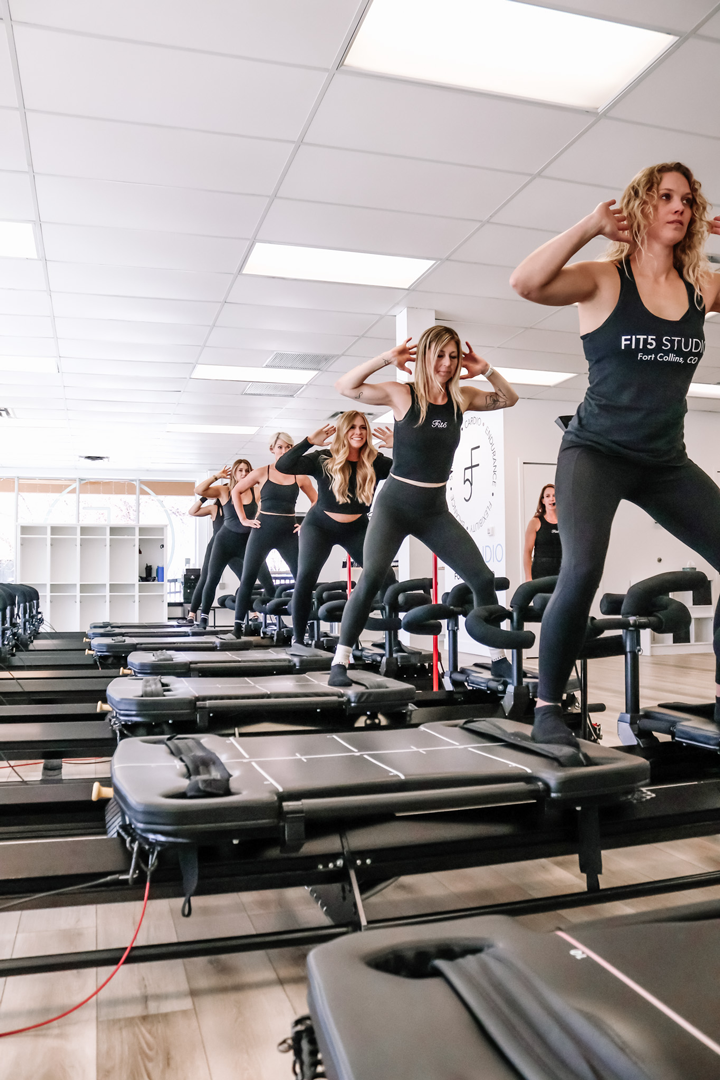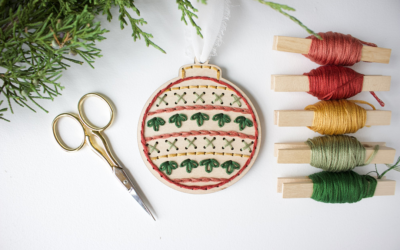Imagine doing a lunge as slowly as you possibly can. Your legs shake in protest, but instead of being a sign to stop, the shakes mean you’re doing it right. And just when you feel like you can’t do another rep, the instructor signals that it’s time to move on to planks.
Pilates and Lagree are two similar fitness methods that test your strength and willpower. Both focus on the time your muscles are under tension, as the instructors guide you through each move on a spring-loaded machine that adds weight and resistance to make it more challenging. The shakes, though unnerving at first, are what make it effective.
“That’s your slow-twitch muscle fibers breaking down,” says Kelsey Miles, one of three owners of Fit5 Studio, a Lagree studio with locations in Fort Collins and Windsor. “That slow twitch is the endurance muscle fibers, so you’re going to build endurance and strength. In traditional strength training, you’re focused on fast-twitch muscles, and you’re not going to feel that.”
Each workout progresses with quick transitions and little to no break time in order to keep the muscles under tension for the entire class. And while Pilates and Lagree use similar equipment, they have key differences that make each method unique.

Fly Fitness
Photo by Leah Faye.
Pilates basics
Pilates was created in the early 1920s by Joseph Pilates, a German anatomist, bodybuilder, gymnast and boxer who developed floor exercises while in an internment camp in England during World War I. He helped rehabilitate others with his exercises, which he enhanced using bed springs, keg rings and other common items.
Those techniques evolved into the Pilates method: A holistic progression of low-impact movements—think ab exercises and leg lifts—designed to stretch and strengthen the body. The exercises are done on a reformer (the spring apparatus) or a mat with the addition of accessories such as a ball,
ring or resistance bands.
Like yoga, the practice involves mind-body awareness and intentional breathing, both of which are necessary to get the most out of the workout, says Staci Lawson, who offers Pilates classes at her studio, Fly Fitness, in downtown Loveland.
“You’re focusing on your breathing and what muscle group the exercise is targeting,” Lawson says. “It sounds crazy, but once you do it, you’re like, ‘Oh yeah, I feel that now that I’m concentrating.’”
Fly Fitness offers a version of Pilates that incorporates “cardio bursts” to make it more of a high-intensity workout while preserving many of the hallmarks of Pilates, including precise, controlled movements and smooth transitions. For example, Lawson’s Pilates classes often begin with a warmup on a “jump board” that you push off with your feet while lying on the reformer. Then you progress through a leg series, core series and arm series to get a total body workout.
“The reformer moves, and sometimes you lay, stand, sit and kneel on it,” Lawson says. “We can add more weights, just like you would add onto a bar if you were lifting in a gym. We can adapt every class to fit people of all athletic abilities.”

Fit5 Studio
Photo by Drops Of Rain Photography.
The Lagree difference
In 1999, Pilates instructor Sebastien Lagree created his own fitness method that adds even more bells and whistles to the reformer. His machine, called the Megaformer, incorporates multiple handlebars, platforms, bungee cords and even more springs to widen the scope of strength-training exercises that can be done on the machine.
“Sometimes I compare it to circuit training,” says Kelsey Vance, co-owner of Fit5. “We’re doing squats, lunges, bicep curls…. It’s like if you go to the gym and do a full-body workout, but we’re going to put you on this machine, and it’s going to be low-impact because of the springs.”
Like with Pilates, Lagree uses slow movements aimed at maximizing the pull or push of each exercise. There is no momentum, which is part of the reason why it’s more difficult than doing bodyweight exercises on a mat. Even though you’re moving as little as five pounds with the springs, it feels heavy because of the resistance that builds as the springs stretch.
Fit5 co-owner Wendy DiMartino discovered Lagree as an avid triathlete, and though she loved running, biking and weight training, she saw the biggest difference in her body through Lagree.
“I had been waking up with back pain, and within weeks of going just a few times, that went away,” she says. “It was because of the core strength. Seeing that improvement and gains as quickly as I did is what sold me on it.”
The high-intensity, low-impact structure of Lagree makes it appealing for people who enjoy HIIT workouts (high-intensity interval training). Since Sebastien Lagree is still alive, new exercises are added to his method all the time. In fact, you’ll probably do different moves on the Megaformer every time you attend a class.
“You can’t emulate it at a [regular] gym,” DiMartino says. “I think about that a lot when I’m in certain moves. I’m like, ‘There’s no way I can do this kind of move anywhere else.’”
An inclusive space
Although the machines are intimidating at first, the group setting of Pilates and Lagree gives newcomers a sense of community. Instructors also have modifications in mind for every movement to make it easier or more challenging based on each person’s comfort level. For example, someone might be fine doing a plank on their hands, while someone else might need to do it on their elbows.
Pilates and Lagree studios welcome anyone to join a class. Lawson has even had kids who dance come and try Pilates.
“We also have men who do it,” she says. “Some of them will say, ‘Why do I need Pilates? I just lift weights.’ Well, it gives them flexibility. We’ve had some men-only classes where they do it with a group of guys and then go have a beer somewhere afterward.”
Pilates exercises can also help athletes improve their performance, Lawson says. Golfers and baseball players often notice better rotations in their swings because their strength and flexibility have improved.
Many of Fit5’s clients are skiers, runners or kayakers who do Lagree in order to get better at those activities, Miles says. They tell her they skied a mogul much better or that they crushed it on the river in a raft because of Lagree. For Vance, doing Lagree even made it easier to have a baby.
“I felt so strong in labor,” she says. “I didn’t even sweat, and I didn’t feel exhausted. I was like, ‘let’s keep going.’”
Climbing for Cardio
When people hear “Lagree,” they sometimes think of VersaClimb, but the two couldn’t be more different. Lagree involves slow movements on a Megaformer, whereas VersaClimb is done on a vertical machine that creates the action of climbing upward with your hands and feet.
“VersaClimb is fast paced, so it’s heavy cardio and fast-twitch muscles,” says Natalie Padgett, owner of GRIT Fort Collins, a fitness studio that offers VersaClimb, Lagree and yoga classes.
VersaClimb gets your heart rate up with long and short steps synched to the beat of the music. The only way it’s similar to Lagree is that the machine has a dial to add resistance. Since they’re opposite in many ways, the two complement each other well.
“The biggest thing to stay healthy is finding any different kind of movement,” Padgett says. “You’ll start to notice that your climbing is a lot stronger because your core is stronger from Lagree.”

GRIT Fort Collins
Photo by Wild Bliss Photography.







